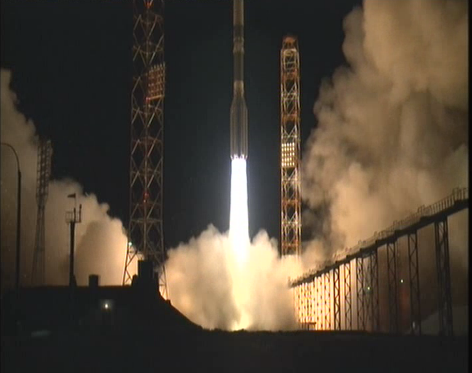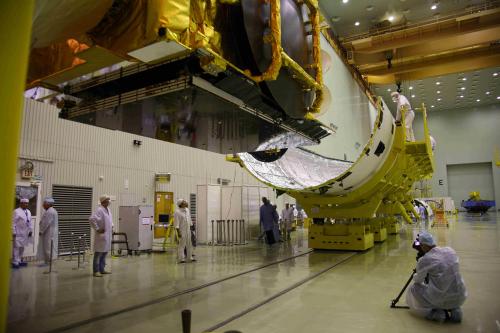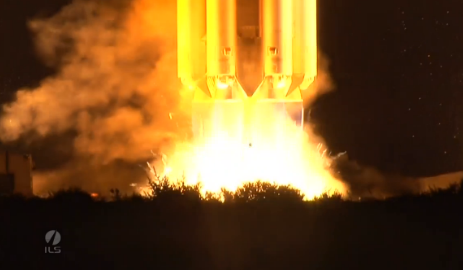
Eighty-nine days after a Khrunichev-built Proton-M booster wobbled, overturned, burst into flames, and crashed in a fireball on the desolate steppe of Kazakhstan, Russia and International Launch Services (ILS) have successfully returned the venerable rocket to flight with a spectacular nighttime mission to insert the Astra 2E communications satellite into a 22,300-mile geosynchronous orbit. Liftoff of the three-stage Proton-M, which also benefited from the presence of a restartable Briz-M upper stage, took place from Pad 39 at Site 200 at the Baikonur Cosmodrome at 3:38 a.m. local time Monday (5:38 p.m. EDT Sunday). A little more than nine hours after launch, following five successful Briz-M burns, the Astrium-built Astra 2E separated from the vehicle and commenced its mission, which will deliver programs to 13 million satellite homes and 3 million cable homes over 15 years.
This launch was long-awaited, coming on the heels of the last Proton mission, which failed a few seconds after launch on 2 July. As highlighted in dramatic YouTube imagery, the 191-foot-tall Proton started pitching wildly to the left and right along its vertical axis shortly after leaving the pad. Efforts to bring these unwanted motions under control by the guidance system were unsuccessful, and the vehicle entered an unmanageable pitchover and hit the ground in a fireball at T+30 seconds. Last month, the Russian government formed the United Rocket and Space Corporation to consolidate the space sector, with Deputy Prime Minister Dmitri Rogozin announcing that it was “so troubled that it needs state supervision to overcome its problems.” The corporation is expected to gain a controlling interest in the Energia rocket engine manufacturer, in which the Russian government already held a 38-percent interest level.

On 13 August, the ILS Failure Review Oversight Board (FROB) and Russia’s State Inter-agency Commission revealed that three angular velocity sensors for yaw control of the Proton’s first stage had been installed incorrectly and formed the root cause of the accident. Moreover, it was suggested that an umbilical separated prematurely, with the vehicle leaving the pad a few tenths of a second early, before the engines had reached full thrust. As it pitched over in its final seconds, the upper stages of the rocket and the payload—a trio of GLONASS navigation satellites—were torn away from the burning Proton and destroyed. “We very much appreciate the time, effort and participation of our customers, the insurance underwriters and technical experts in the FROB process,” said John Palmé, ILS Vice President of Programs and Operations. “They worked tirelessly with us to ensure that the review was conducted thoroughly. As we work towards the return to flight of the Proton vehicle, we thank all of our customers for their continued support.” The accident marked the first failure by a Proton during first-stage flight in over 30 years.
At the time of the accident, efforts had entered high gear for the launch of Astra 2E aboard the very next Proton. The cube-shaped spacecraft—built by the Luxembourg-based SES global satellite provider—arrived at Baikonur in mid-June, followed by the Proton’s restartable Briz-M upper stage a few days later. Liftoff was scheduled for the night of 20/21 July, but was put on indefinite hold in the wake of the accident. Eventually, ILS announced that it was tracking a new launch date in mid-September, but technical troubles rendered this target unachievable. Detoxification of the accident zone and reports from ILS relating to “an out-of-tolerance reading in the first stage of the vehicle” conspired to delay the launch by two weeks. On 22 September, a new launch date and time of 3:38 a.m. local time Monday, 30 September (5:38 p.m. EDT Sunday 29th) was scheduled. Rollout of the Proton-M and Astra 2E payload to Pad 39 at Site 200 occurred on 26 September.
All three stages of the booster are propelled by nitrogen tetroxide and unsymmetrical dimethyl hydrazine, the loading of which got underway at Baikonur at 9:40 p.m. local time (11:40 a.m. EDT) Sunday. Preparations proceeded with exceptional smoothness, and at 2:30 a.m. local time Monday (4:30 p.m. EDT Sunday) the launch tower was rolled back to expose the 1.5-million-pound Proton, whose heritage spans almost 400 missions since the mid-1960s and carries one of the world’s most reliable track records for success. At T-5 minutes, the Briz-M upper stage—also fueled by nitrogen tetroxide and unsymmetrical dimethyl hydrazine—was transferred to internal power and confirmed its status as healthy. Ignition of the six RD-276 first stage engines commenced at T-2 seconds, ramping up to 100 percent rated performance and producing an estimated 2.3 million pounds of thrust. Liftoff occurred spectacularly and on time at 3:38 a.m. local time Monday (5:38 p.m. EDT Sunday), and a little more than a minute into the ascent the Proton encountered an expected period of maximum aerodynamic turbulence—known as “Max Q”—on its flight surfaces.

Separation of the first stage occurred two minutes into the mission, after which the four engines of the second stage roared to life and propelled the vehicle uphill for a further 3.5 minutes with a combined 540,000 pounds of impulse. Shortly after the departure of the second stage, the Payload Fairing (PLF)—which encapsulated the Astra 2E payload and protected it from aerodynamic effects in the low atmosphere—was jettisoned and the single third stage engine added an extra 138,000 pounds of thrust for the next four minutes of the flight. Its shutdown came precisely on time, about 10 minutes after leaving Baikonur. By this time, the vehicle had been inserted onto a suborbital trajectory.
All phases of the ride on the Proton appeared to be nominal, and the turn now came for the Briz-M upper stage, which has the capability to restart up to eight times, but which was assigned a five-burn flight profile on this mission. The Briz-M and the attached Astra 2E separated at about 3:50 a.m. local Baikonur time Monday (5:50 p.m. EDT Sunday), and the first burn, lasting about 4.5 minutes, got underway. Since its maiden voyage, back in May 2000, the Briz-M has exhibited a mixture of success and failure. In August 2012, a premature shutdown left Indonesia’s Telkom-3 and Russia’s Ekspress-MD2 satellites in useless orbits, and in December 2012 another glitch impacted the Yamal-402 satellite. Last March, however, a Proton-M/Briz-M successfully injected Mexico’s Satmex-8 communications satellite into orbit.

Following the first burn of the Briz-M, the combo entered a circular “parking orbit” and coasted for about an hour, preparatory to the second burn. This was a much longer firing of almost 18 minutes, which ended a few seconds earlier than intended, but did not prove detrimental to the overall conduct of the mission. A third burn of 11.5 minutes and a fourth of about six minutes in duration followed, ending at 7:55 a.m. Baikonur time Monday (9:55 p.m. EDT Sunday). At this stage, the Additional Propellant Tank (APT) separated, as planned, and the vehicle coasted for about five hours, ahead of the fifth and final Briz-M burn at T+8 hours and 53 minutes. This six-minute firing commenced perfectly and on time and at 12:59 p.m. Baikonur time (2:59 a.m. EDT) Monday—precisely on time—Astra 2E separated from the Briz-M.
Owned and operated by the Luxembourg-based SES global satellite provider, Astra 2E will be positioned at 28.2 degrees East in geosynchronous orbit. Equipped with three Ku-band downlink beams covering Europe and the Middle East, it will provide digital television and satellite broadband services for Europe and the Middle East. It forms the second of three “second-generation” satellites assigned to the 28.2 degrees East orbital position. Astra 2F was launched by Europe’s Ariane 5 in September 2012, and Astra 2G will fly in spring 2014. Upon arrival in its orbital slot and after initial checkout, Astra 2E will take over the channels currently broadcast by the Astra 1N satellite.
“As we continue our long-standing relationship with SES, we value each mission,” said ILS President Phil Slack, after the successful launch. “Beginning in 1996 with the launch of Astra 1F, Astra 2E is now the 23rd ILS Proton launch for SES. We thank the individual teams at SES, Astrium, Khrunichev, and ILS for their commitment to launch success. Most of all we thank SES for their trust in ILS and Khrunichev to support their plans for expansion. We look forward to many more years of working together.” It was added by SES CEO Romain Bausch that the new satellite would provide a growth and replacement capability for the orbiting network of Astra satellites. “Astra 2E is now poised to help ensure reliable and secure connectivity,” Bausch said. “This is the 54th satellite launch for SES, and almost half of our fleet has been launched by ILS Proton. We appreciate the determination and dedication that the ILS and Khrunichev teams consistently provide to SES.”
Want to keep up-to-date with all things space? Be sure to “Like” AmericaSpace on Facebook and follow us on Twitter: @AmericaSpace




3 Comments
3 Pings & Trackbacks
Pingback:Faulty Valve Replacement Delays ULA’s Next Delta IV Launch « AmericaSpace
Pingback:ILS Regains Confidence in Proton-M Booster as Long-Delayed Sirius FM-6 Launch Nears « AmericaSpace
Pingback:Sirius Rising: Proton-M Ready to Launch Digital Radio Satellite Into Orbit « AmericaSpace